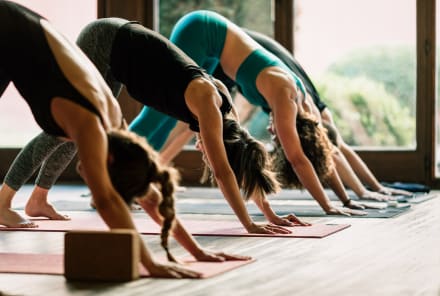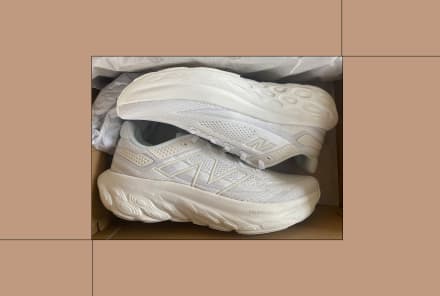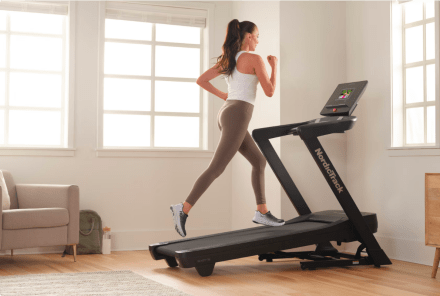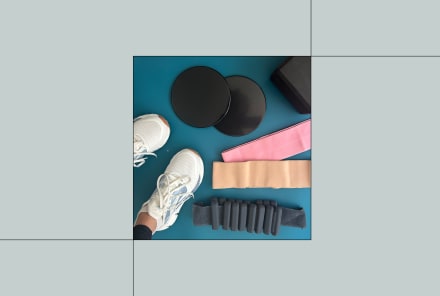Advertisement
Should You Do Cardio Before Or After Weights? Here's How To Choose

Hannah Frye is the Assistant Beauty Editor at mindbodygreen. She has a B.S. in journalism and a minor in women’s, gender, and queer studies from California Polytechnic State University, San Luis Obispo. Hannah has written across lifestyle sections including health, wellness, sustainability, personal development, and more.

There's really no one-size-fits-all approach to exercise, but there are some tweaks you can make to get the most out of your workouts based on your goals. The order of your exercises is one of those tweaks, which brings us to the question we're tackling today: Should you start with cardio or weights?
Should you do cardio before or after weights?
Let's dive right in: There's no definitive answer to whether you should start with cardio or weight training—it all depends on your fitness objectives.
For instance, if you're gearing up for a race or prioritizing heart health benefits, cardiologist David Sabgir, M.D., suggests kicking off your workout with cardio. There are many reasons for this, and one is quite obvious: You want to give the most energy to the exercise you're prioritizing. So, if you're focused on endurance, spending half an hour weight training before could limit your cardio performance.
On the other hand, if you're working toward fat loss1, weight reduction, or muscle gain, start with weight-bearing exercises before engaging in strenuous cardio. Sabgir warns that cardio may cause muscle fatigue, potentially reducing your strength during weightlifting and increasing the risk of injury.
However, there are advantages to starting with a light cardio warm-up before weight training, even if you're focused on muscle building or fat burning. Certified personal trainer Daniel McKenna recommends an incline walk or quick stair climbing session to warm up without overly fatiguing muscles, which could compromise your weightlifting performance.
Sabgir also highlights a small study suggesting that cycling for 20 minutes before weight training could enhance muscle growth more than weightlifting alone2. However, the participants in this study completed cycling before a tricep exercise, so they were working different muscle groups during their cardio and weight training.
So, while you shouldn't exhaust yourself with cardio before lifting if muscle gain is your goal, a cardio warm-up can support your objectives compared to starting without any warm-up at all.
Pros and cons of each
Say you're not sure what your goal is. In that case, scan these pros and cons lists to get a feel for what you might want to put first. Remember that you can switch up your fitness routine as you see fit, so you don't have to commit to putting one before the other every single time.
Pros of doing cardio before weights
- Light cardio warms up your muscles: As stated above, a light cardio exercise such as speed walking or using the elliptical can help warm up your muscles ahead of lifting. If you're focused on muscle gains, keep this warm-up short and sweet so you don't tire yourself out.
- Your cardio endurance will be better: Whether you're training for a specific event, such as a marathon, or you just want to focus on your endurance, completing this exercise ahead of touching any weights is your best bet for performance.
Pros of doing cardio after weights
- Your lifting potential will be higher: If you start your workout with a few miles of running before lifting weights, your muscles will likely be fatigued, making it harder to lift heavy weights or do as many reps. Opting for a short cardio warm-up followed by weight lifting can prevent this. If you prefer doing more cardio after your weight training, you can still incorporate it into your routine.
- Light weights can enhance your cardio experience: "You can lift weights to prime your muscles to help improve your running workout, but not too much that it takes away from it," McKenna says. Even if your cardio session is longer and more challenging, especially for those focused on endurance, incorporating a light weight-lifting session before can still be beneficial as a warm-up for your main cardio workout.
How often to do each
Everyone has a different ideal workout schedule, and it largely depends on what kind of exercise you choose. According to the Centers for Disease Control and Prevention (CDC)3, adults should aim to:
- Complete strengthening activities that work all the major muscle groups (legs, hips, back, abdomen, chest, shoulders, and arms) at least 2 days a week.
- Perform at least 150 minutes of moderate-intensity activity a week or 75 minutes of vigorous-intensity activity a week spread evenly over 4 to 5 days a week, or every day.
- Reduce time spent sitting or lying down, and break up long periods of not moving with some activity.
As McKenna says, "As long as you're moving your body and walking every day, you're on the right track." So don't get too caught up in the numbers if you're still easing into a workout regimen.
What is the best type of cardio to do with weight training?
If you're looking to integrate cardio into your weight training routine (or vice versa), there are some best practices for choosing your cardio method.
When focusing on specific muscle groups to maximize gains and recovery, it's common to prioritize different areas on different days. Some days may focus on the upper body (back, biceps, triceps, chest), while others target the lower body (glutes, quads, calves). Here's McKenna's advice on incorporating cardio into your split routine:
- On upper-body days, McKenna advises doing cardio either before or after your weight training session—whichever you prefer. Choose a form of cardio that primarily engages your legs (like running or using a stair stepper) rather than your arms if you decide to do it before.
- On leg days, "I recommend a 10-minute walk beforehand to loosen your muscles and prepare your glutes, thighs, and hamstrings for strength training," McKenna suggests. "The last thing you want is to go for a run after deadlifting 150 pounds." If you opt for more intense cardio on these days, do it after your weight training session to avoid compromising your lifting performance.
PSA: You may want to change your shoes
If you decide to pair weight lifting with running as your cardio form, you may want to bring another pair of shoes.
Running shoes tend to have more cushion to support your foot, while weight-training shoes tend to be flat on the bottom. If you choose just one, go with the running shoe for both activities and consider a lower-level cushion to satisfy both needs.
Making a shoe swap (or finding a middle-ground pair) will help you prevent injury when running and may even make that cardio exercise more enjoyable.
Arguments against mixing cardio and weight training
If the idea of combining cardio and weight training in one day makes you cringe, don't worry—you don't have to mix them. In fact, some people prefer to keep these activities separate to allocate more energy to their primary focus.
One 2022 research review suggests that while concurrent cardio and strength training do not deplete muscle gains or overall strength development, they can hinder explosive strength capacity4.
So if your workout plan requires explosive strength (think box jumps, for example), it may be worth booking cardio on separate days.
It's personal
FAQ
Does cardio after weights affect muscle growth?
One 2022 research review suggests that while concurrent cardio and strength training do not deplete muscle gains or overall strength development, they can hinder explosive strength capacity.
Is it better to run before or after lifting weights?
On upper-body days, McKenna advises doing cardio either before or after your weight training session—whichever you prefer. Choose a form of cardio that primarily engages your legs (like running or using a stair stepper) rather than your arms.
On leg days, "I recommend a 10-minute walk beforehand to loosen your muscles and prepare your glutes, thighs, and hamstrings for strength training," McKenna suggests. "The last thing you want is to go for a run after deadlifting 150 pounds." If you opt for more intense cardio on these days, do it after your weight training session to avoid compromising your lifting performance.
Should I do cardio or weights first to lose belly fat?
There are advantages to starting with a light cardio warm-up before weight training, even if you're focused on muscle building or fat burning. Certified personal trainer Daniel McKenna recommends an incline walk or quick stair climbing session to warm up without overly fatiguing muscles, which could compromise your weightlifting performance.
The takeaway
The decision to prioritize cardio or weight training in your workout routine depends on your specific fitness goals and preferences. If your goal is to boost endurance, put cardio first on the list. For those seeking weight loss, muscle gains, or increased strength, make weight training your priority. No matter what, remember that working out in any capacity is better than nothing, and exercise is highly personal. Feeling inspired? Consider these trainer-approved cardio workouts the natural next step.
Watch Next
Enjoy some of our favorite clips from classes
Enjoy some of our favorite clips from classes
What Is Meditation?
Mindfulness/Spirituality | Light Watkins
Box Breathing
Mindfulness/Spirituality | Gwen Dittmar
What Breathwork Can Address
Mindfulness/Spirituality | Gwen Dittmar
The 8 Limbs of Yoga - What is Asana?
Yoga | Caley Alyssa
Two Standing Postures to Open Up Tight Hips
Yoga | Caley Alyssa
How Plants Can Optimize Athletic Performance
Nutrition | Rich Roll
What to Eat Before a Workout
Nutrition | Rich Roll
How Ayurveda Helps Us Navigate Modern Life
Nutrition | Sahara Rose
Messages About Love & Relationships
Love & Relationships | Esther Perel
Love Languages
Love & Relationships | Esther Perel












